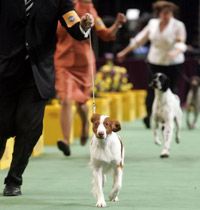Quck answer
Dog shows are competitions where dogs are judged based on how well they meet breed standards. The dogs are evaluated on factors such as their physical appearance, movement, and temperament. There are different levels of competition, from local shows to national and international events. Dogs are divided into groups based on their breed, and winners from each group go on to compete for Best in Show. The judges are experts in the particular breed being evaluated and use a point system to determine the winners. Dog shows are not only a chance for dogs to compete, but also a way for breeders and owners to showcase their dogs and promote responsible pet ownership.
Animal Information
The Journey to Best in Show

Elite Canines Compete for Honor at Westminster Dog Show
Stephen Chernin/Getty Images
Out of the numerous dog breeds that exist, the AKC acknowledges slightly over 150 [source: AKC]. The AKC then categorizes these breeds into groups that generally differentiate them based on the purposes they were initially bred for. These groups include:
- Sporting dogs: These dogs are bred for sporting purposes, such as hunting. This group includes pointers, retrievers, setters, and spaniels.
- Hounds: Hounds, such as beagles, bloodhounds, and dachshunds, often possess exceptional senses of smell or physical endurance that can make them effective hunters.
- Working dogs: With their large sizes and great strength, the dogs in this group make excellent assets in practical tasks such as search-and-rescue and guarding your home. Examples include Great Danes, Rottweilers, and Saint Bernards.
- Terriers: This group encompasses all terriers, who are known for their distinct and energetic personalities. Some examples include bull terriers, Scottish terriers, and miniature schnauzers.
- Toy dogs: This group comprises small dogs, such as the Chihuahua, that are often seen being carried around by celebrities. Toy dogs include Shih Tzus, poodles, and pugs.
- Non-sporting dogs: This is a miscellaneous category for breeds that don’t share any unifying characteristics. It includes the bulldog, Dalmatian, and American Eskimo dog.
- Herding dogs: As the name suggests, people breed these dogs to herd animals such as sheep and cows. Breeds in this group include collies, Australian shepherds, and briards.
- Miscellaneous: As part of the recognition process, the AKC allows breeds into this group that have generated popularity and interest over a wide area. Breeds in this group, however, cannot earn championship points in conformation shows. If the breeding activity grows for a breed in this class, the AKC might recognize it in one of the other groups.
[source: AKC]
The Best of Breeds in each group compete against each other in group shows. If a dog wins first prize at its group show, then it goes on to compete in an All-Breed show, like Westminster. In an All-Breed show, before dogs compete against other groups, they must defeat other first-prize winners in their group. Finally, after the judges have narrowed it down to seven winners from the seven different groups (the miscellaneous group cannot compete), they award Best in Show, the highest prize, to the best dog.
The meticulous judging process and competitive atmosphere explain why people become so passionate about their show dogs, despite the fact that there is no significant prize at the end of the road. However, is this system ultimately detrimental to dogs? Discover what critics have to say about dog shows on the next page.
FAQ
1. What is a dog show?
A dog show is a competition where dogs are judged based on how closely they match their breed standards. It is an opportunity for breeders and owners to showcase their dogs and for judges to evaluate them based on their physical appearance, movement, and temperament. Dog shows can be held locally or nationally and attract thousands of participants and spectators.
2. How are dogs judged in a dog show?
Dogs are judged by a panel of experts who are well-versed in the breed standards. The judges evaluate each dog based on its conformation, movement, and overall health. Conformation refers to the physical features and structure of the dog, including its coat, head, body, and tail. Movement is evaluated by how smoothly and efficiently the dog moves around the ring. Judges also consider the dog’s temperament and behavior, as it should be friendly and well-behaved.
3. What are the different categories in a dog show?
Dogs are grouped into different categories based on their breed, size, and purpose. The American Kennel Club (AKC) recognizes seven groups: Sporting, Hound, Working, Terrier, Toy, Non-Sporting, and Herding. Each group is then further divided into specific breeds. For example, the Sporting group includes breeds such as Golden Retrievers, Labrador Retrievers, and Cocker Spaniels.
4. Can any dog participate in a dog show?
No, not every dog can participate in a dog show. Only purebred dogs with papers or those registered with a kennel club are eligible to compete. The dog must also meet the breed standards and be in good health. It is important to note that participating in dog shows should not be the sole reason for breeding dogs, as responsible breeding practices prioritize the health and well-being of the dogs above all else.
5. What are the benefits of participating in a dog show?
Participating in a dog show can provide numerous benefits for both the dog and its owner. It is an opportunity to showcase the dog’s breeding and training, as well as to socialize and network with other breeders and owners. Winning a dog show can also increase the dog’s value and reputation, which can lead to more breeding opportunities and higher prices for puppies. Additionally, participating in dog shows can be a fun and rewarding experience for both the dog and its owner, as they get to travel and meet new people while bonding with their beloved pet.





Leave a Reply